This beautiful story, he wrote Mr. Wolf.
Crystal Palace takes its name from the great iron and glass building in 1851 at the behest of Prince Albert, consort of Queen Victoria, was installed in the heart of Hyde Park to host "The Great Exhibition", the Great Exhibition which was to symbolize industrial power, economic, and military of the British Empire.
Here is a photo of this curious building, huge, and dominated by two large towers on either side.
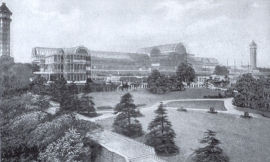

Since it was made of prefabricated parts, in 1854 the building could be disassembled and reassembled in the south of the city, Sydenham Hill, where he became a ' tourist attraction as well (for our purposes) within the sporting events.
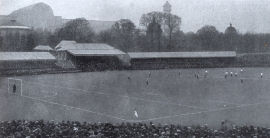
THE FIRST CRYSTAL PALACE FC - In 1861 employees of Crystal Palace football club founded a self-titled, which in 1871 was among the founding members of the FA Cup, an event in which the team, for which the colors were chosen rossoblù, participated until 1876, when the club broke up.
But now the Crystal Palace was the place chosen sports competition, Wembley was still to come on that field and they quarreled over the Cup final until 1916.
the birth of the CRYSTAL PALACE FC - In 1905 another club was founded, not connected with the previous one, which sought to play on the field adjacent to the great Crystal Palace (Who rented it) and where, therefore, was again given the name of Crystal Palace.
to form a new club we enlisted the cooperation of the secretary of Aston Villa (who was then the biggest club in England) who then, thanks to the friendship between the Director of Crystal Palace and the chairman of Aston Villa , left the club in Birmingham to become secretary of the newborn Crystal Palace FC.
It's no wonder that the Crystal Palace took the same shirt the Villans.
In practice, the Crystal Palace began as a sort of cockney Aston Villa.
The club played in the first year in the Southern League by taking as a symbol of the palace of glass and with it the nickname of Glaziers, Glaziers
the

Here is a picture of Crystal Palace Sports Ground, where matches are played, the Glaziers.

THE NEST OF (FUTURE) EAGLES at Selhurst Park - With the First World War, the site of the Crystal Palace was requisitioned for military necessity, and the club moved (to compete in some local leagues, local wartime) plant in Herne Hill, where he played the West Norwood FC.
After the war he moved to Crystal Palace Selhurst, the the same area where it is now, in a stadium called The Nest, Eagles Nest, as the old stadium of Norwich, owned by the London, Brighton and South Coast Railway Company (now the site is used as a train depot, opposite the station Selhurst).

In 1924 the Crystal Palace was able to buy land to build the stadium to Selhurst Park. Where
Selhurst Park?
's hard to explain, say it is far, far away.
from all.
Who went on vacation studio in London knows that the destination for a stay was Wimbledon, the most Morden were lost or (if you were just unlucky) Mitcham.
Well, Selhurst is even further away, in south-east of Mitcham, with no subway that passes nearby, you got to get there by train or bus.
short, it is far ....
The field, however (say those who saw him as the Lord and Arsenal4Ever) is very beautiful and traditional, and the pictures seem to give their reason.

TEAM YO-YO - In the first half of the twentieth century Crystal Palace leads a life quite stunted, the classic yo-yo club going up and down from the lower division, reaching up to the Second.
In the '30s, however, shines the star of Peter Simpson, the largest bomber ever, with 165 goals in 195 games, capable of scoring a record 46 goals in 42 games in 1930-1931.

Meanwhile, winds of war, in 1936 the famous Crystal Palace was destroyed by German air bombardment.
Even football is affected and during the warmest years of the conflict are held only in local or regional tournaments. In the seven years of war-time football, however, well 186 players wear the shirt of the Crystal Palace ( http://www.cpfc.co.uk/page/History/0,, 10323 ~ 754,182.00. html).
Only in 1961 the Crystal Palace regained the Second Division after 40 years of absence, and in 1969 for the first time reached the First Division (it was now, what do you think?).
The 60s are dominated by abstraction of the talented forward Johnny Byrne, one of the legends of the Crystal Palace of all time, who was also called to the glorious white jersey dress with the three lions.
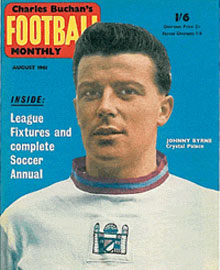
here she is, nice and sober style of the time, greets his wife to go to training National.

In the 1972-73 season with the Palace beats the historic achievement of the poor Manchester United 5-0 at the time, but at the end of the season were relegated to Second Division, and within a year anything but enviable complete a "double", sadly back in third.
DO THE EAGLES AND BEGINS TO FLY - At this point the club in an attempt to regain the favor of Fortune, change the colors, from claret and blue of the early years, which had been raised in countless versions (Including the edges or white shirt with claret and blue socks), a lively combination of bright red and bright blue, in memory of those who were the colors of the original Crystal Palace.
The nickname change from Glaziers, regarded as too simple, the aggressive Eagles. The crest
change, the glass building is now topped by an eagle, first designed in the style phoenix rising from its ashes (a metaphor to remind the bombing of the palace of glass), then in a horrific cut aggressively.
The change seems to work. The club comes first from mediocrity.
After a series of ups and downs between the First and Second Division in 1989, the Crystal Palace, under the guidance Steve Coppell, won the Second Division play-off with a fast-paced, witty and offensive, and sensational two strikers like Mark Bright and Ian Wright (who would become the most prolific scorer in the history of Arsenal before being overtaken by the great Thierry Henry).

THE GOLDEN ERA - In 1990, the Palace arrives in the FA Cup final with Manchester United losing the replay after was in the lead until late in the first final, and after beating Liverpool 4-3 in a memorable semi-final.
Season Next, then in 1991, the Palace touches the highest point in its history, coming third in the league and returning to Wembley to win the League Cup.

The Epic of bald eagles and a return to mediocre ' - In 1993, the Golden Era is over and they begin the roller coaster before and Second Division. After two
League semi-finals of the FA Cup and lost in 1995 with Liverpool and Manchester United in the summer of 1997 was signed Attilio Lombardo, called Bold Eagle, Bald Eagle, which in one year and a half left an indelible mark on fans, but the club no longer has a penny to pay the players and is forced to sell en masse, of course, relegated to the second division, all wonderful in the summer of 1998 Lombardo says it will remain at the Palace groped for the slope, but things go from bad to worse, and will return to Lazio in mid-season.

During this period, with many shadows and let the coach Terry Venables is the controversial chairman Mark Goldberg, who has dragged the club to the brink of bankruptcy.
Finally in 2000, after a period of administration, comes as new chairman and owner Simon Jordan, a man with the Eagles in the heart, which puts the financing needed to avoid bankruptcy, and goes in search of the longed-for revival.
In 2004, the Palace, now under the guidance of Ian Dowie, beat in the final of the playoffs and back to West Ham in the Premier League, but only for a year, because once again relegated in 2005 after a thrilling final, despite graduating Andrew Johnson Vice-capocanoniere with 21 goals.

In subsequent seasons the Eagles, under the guidance of Peter Taylor's first, then Neil Warnock, are eliminated in the play offs, and the rest as they say, is history now, yo-yo with the team involved in yet attempt to engage the promotion, which will win sooner or later, then back the following year.
Call him if you want, EMOZIOOOOOOOOOOOOOOOOOOOOOOOONI - Of course, the existence of a fan of the Palace is anything but boring. Indeed those who, like myself, believes that the excitement of a promotion obtained in a final (as Padova / Cesena in 1994 in Cremona), or a salvation won on the last day or the play-off (Padova / 1995 Genoa, Florence) are equivalent to a championship, and he who considers the promotion and salvation as an exciting championship, I said, is convinced that the fan of the Palace, which almost every year a final dispute or for promotion or for salvation, living more emotion than not, I say, a fan of Tottenham, who lives a monotonous series of boring centroclassifica championships.
COLOURS - conclude with the colors. As we said, from its origins to 1973, the colors are claret and blue, was initially copied the model Aston Villa jersey with sleeves and claret sky, then these two beautiful colors were combined in an original.
The finest mesh (one of the most beautiful of all time, I would say, and not Only the Palace) is white with blue and burgundy double vertical band used in the early 70s.

Since 1974, it will be recalled, have changed the logo, nickname and team colors, switching to a lively combination of red two-tone bright blue, and since then have always alternated models (sometimes truly "spectacular") of the striped shirt (as appropriate, with central red stripe or blue) and with the white diagonal band rossoblù (a favorite of supporters).
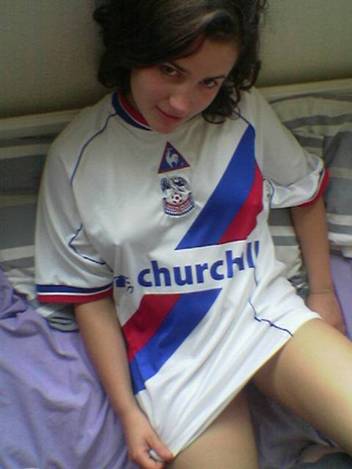
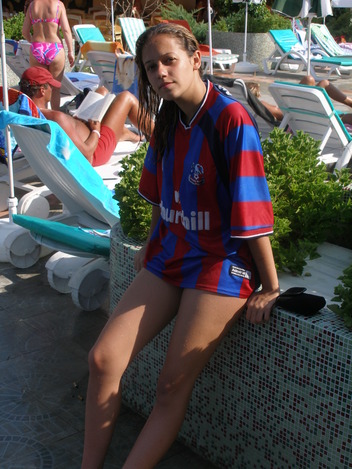

0 comments:
Post a Comment